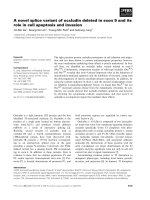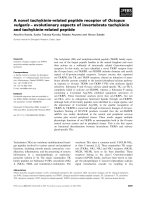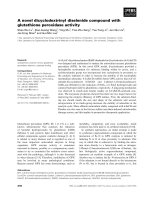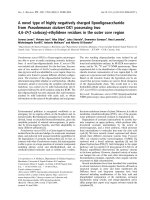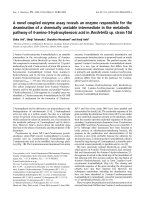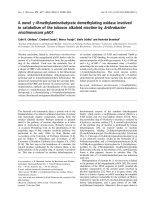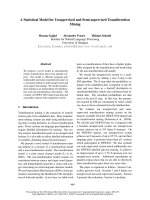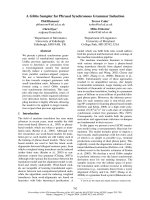Báo cáo khoa học: A novel pathway for sequential transformation of 7-dehydrocholesterol and expression of the P450scc system in mammalian skin pptx
Bạn đang xem bản rút gọn của tài liệu. Xem và tải ngay bản đầy đủ của tài liệu tại đây (580.92 KB, 11 trang )
A novel pathway for sequential transformation of 7-dehydrocholesterol
and expression of the P450scc system in mammalian skin
Andrzej Slominski
1
, Jordan Zjawiony
3
, Jacobo Wo rtsman
4
, Igor Sem ak
5
, Jeremy Stewart
3
,
Alexander Pisarchik
1
, Trevo r Sweatman
2
, Josep Marcos
6
, Chuck Dunbar
3
, Robert C. Tucke y
7
Departments of
1
Pathology and Laboratory Medicine, and
2
Pharmacology, University of Tennessee, Health Science Center, Memphis,
TN, USA;
3
Department of Pharmacognosy, University of Mississippi, University, MS, USA;
4
Department of Medicine, Southern
Illinois University, Springfield, IL, USA;
5
Department of Biochemistry, Belarus State University, Minsk, Belarus;
6
Children’s Hospital
Oakland Research Institute, Oakland, CA, USA;
7
Department of Biochemistry and Molecular Biology, School of Biomedical and
Chemical Science, University of Western Australia, Crawley, Australia
Following up on our previous findings that t he skin pos-
sesses steroidogenic activity from progesterone, we now
show widespread cutaneous expression of the full cyto-
chrome P450 side-chain cleavage (P450scc) system required
for the intracellular catalytic production of pregnenolone,
i.e. the genes and proteins for P450scc enzyme, adrenodoxin,
adrenodoxin reductase and MLN64. Functionality of the
system was confirmed in mitochondria from skin cells.
Moreover, purified mammalian P450scc enzyme and, most
importantly, mitochondria isolated from placenta and
adrenals produced robust transformation of 7-dehydro-
cholesterol (7-DHC; precursor to cholesterol and vitamin
D3) to 7-dehydropregnenolone (7-DHP). Product i dentity
was confirmed by comparison with the chemically synthe-
sized standard and chromatographic, MS and NMR
analyses. Reaction kinetics for the c onversion of 7-DHC i nto
7-DHP were similar to those f or cholesterol c onversion
into pregnenolone. Thus, 7-DHC can form 7-DHP through
P450scc side-chain cleavage, which may serve as a substrate
for further conversions into hydroxy derivatives through
existing steroidogenic enzymes. In the skin, 5,7-steroidal
dienes (7-DHP and its hyd roxy derivatives), whether syn-
thesized locally or delivered by the circulation, may undergo
UVB-induced intramolecular re arrangements to vitamin
D3-like derivatives. This novel pathway has the potential to
generate a variety of molecules depending on local steroido-
genic activity and access to UVB.
Keywords: 7-dehydrocholesterol; 7-dehydropregnenolone;
cytochrome P450scc; skin; ultraviolet radiation.
The skin, the largest body organ, maintains internal
homeostasis by not only separating the external environ-
ment from the internal milieu, but also through its immune
and neuroendocrine activities [1–3]. Cutaneous elements can
in addition have powerful systemic actions as is the case for
vitamin D3 [1], which regulates calcium metabolism, and
modulates immune and neuroendocrine activities and
proliferation and differentiation in cells of different lineages
[4–6]. Vitamin D3 i s formed from t he precursor steroid
7-dehydrocholesterol (7-DHC) localized mostly on the
plasma membrane of basal epidermal keratinocytes (80%
of skin 7-DHC content). Upon stimulation with photons of
UVB (wavelength 290–320 nm), 7-DHC undergoes photo-
lysis to generate previtamin D3, which, at normal skin
temperature, undergoes internal rearrangement to vitamin
D3 [4,7].
Cytochrome P450 side-chain cleavage (P450scc) is a
product of the CYP11A1 locus thought until recently to use
solely cholesterol as substrate, which is then hydroxylated
and cleaved on the side chain. The reaction takes place at a
single active site on the cytochrome to produce pregneno-
lone [8]. Electrons for the hydroxylations are provided by
NADPH through t he electron t ransfer proteins a dreno-
doxin reductase and adrenodoxin [8,9]. This biochemical
pathway may be operative in the skin, as it expresses the
related CYP11A1, CYP17, CYP21A2 and MC2-R genes
[10]. Furthermore, skin and skin cells can rapidly and
selectively m etabolize progesterone and deoxycorticoster-
one to a number o f intermediates that include deoxy-
corticosterone, 18-hydroxy deoxycorticosterone and
corticosterone, c onsistent with active local steroidogenesis
[11–14].
Interest in the P450scc system has been renewed by recent
findings in patients with the rare Smith–Lemli–Opitz
syndrome whose c holesterol synthesis from 7-DHC is
impaired because of a deficiency of the 7-DHC D7 reductase
[15,16]. Patients with S mith–Lemli–Opitz syndrome accu-
mulate 7-DHC and also have noticeable amounts of
7-dehydropregnenolone (7-DHP) (and its metabolites)
suggesting enzymatic production from 7-DHC [17,18].
Correspondence to A. Slominski, Department of Pathology and
Laboratory Medicine, University of Tennessee, Health Science
Center, Memphis, TN, USA. Fax: +1 901 448 6979,
Tel.:+1 901 448 3741, E-mail:
Abbreviations: 7-DHC, 7-dehydrocholesterol; 7-DHP, 7-dehydro-
pregnenolone; P450scc, cytochrome P450 side-chain cleavage; FDX1,
adrenodoxin; FDXR, adrenodoxin reductase; MO-TMS, methyl-
oxime-trimethylsilyl.
(Received 29 July 2004, revised 30 August 2004,
accepted 3 September 2004)
Eur. J. Biochem. 271, 4178–4188 (2004) Ó FEBS 2004 doi:10.1111/j.1432-1033.2004.04356.x
Furthermore, in mo st recent studies with an in vitro system
of reconstituted P450scc, 7-DHC and vitamin D3 were
found to serve as alternative substrates for cytochrome
P450scc [19].
Within the context above, the skin presents the unique
situation of having readily available all the p otential
substrates for P450scc, e.g. cholesterol, 7-DHC and vitamin
D3, thus providing the background for a systematic
investigation on the cutaneous expression of each of the
components of the P450scc enzymatic system. In addition,
we tested reconstituted a nd mitochondrial P 450scc systems
for t heir ability to convert 7-DHC into 7-DHP.
Materials and methods
Biological materials
Tissue. Human skin and placenta were obtained from
discarded biopsy material or surgical specimens, or after
delivery. The corresponding protocols w ere reviewed and
approved by the University of Tennessee Institutional
Review Board as an exempt protocol [under
45CFR46.102(F)] entitled ÔSkin as a neuroendocrine organ Õ
with original IBR date o f approval of 19 July 2000.
RNA from C57BL/6 mice was isolated at the Albany
Medical C ollege and stored at )80 °C. The skin and internal
organs were harvested f rom f emale C 57BL/6 mice aged
8 weeks at telogen and anagen stages of the hair cyc le as
described previously [20]. Adrenals were obtained from
Wistar rats killed under anesthesia. Male rats aged
3 months were obtained from t he vivarium of the Depart-
ment of Biotestings of Bioorganic Chemistry Institute
(Minsk, Belarus) ( detailed protocols were described previ-
ously) [21]. The Institutional Animal Care and Use Com-
mittee at AMC approved the original protocol, and a
similar protocol for mice was approved at UTHSC; for
LC/MS a ssays the experiments were approved by the
Belarus U niversity Anim al Care and U se Committee.
Cell lines. Cultures of normal and immortalized keratino-
cytes, dermal fibroblasts, melanocytes and melanoma cells
were carried out according to s tandard protocols described
previously [12,22,23]. Normal human epidermal k eratino-
cytes and melanocytes, and dermal fibroblasts were
obtained from Cascade Biologics, Inc. (Portland, OR,
USA) and cultured as described previously [24].
Mitochondrial fractions and enzymes. Mitochondrial
fractions of the test tissue (skin, adrenals or placenta) were
prepared by homogenizing the tissue in 5 vols ice-cold
0.25
M
sucrose containing protease inhibitor cocktail
(Sigma) [25]. The homogenate was centrifuged at 600 g
for 10 min at 4 °C, and the resulting supernatant was
centrifuged at 6000 g (placenta) or 9000 g (skin and
adrenals) for 20 min at 4 °C to sediment the mitochondrial
fraction. The pellet was resuspended in 0.25
M
sucrose, and
the mitochondrial f raction was again sedimented under the
same conditions. The washed mitochondrial fraction was
resuspended in 0.25
M
sucrose and used for enzymatic
reaction. For cultured skin cells, the above procedure was
carried out after the cells had been swelled for 30 min i n
20 m
M
HEPES, pH 7.4, before homogenization.
Bovine cytochrome P450scc, adrenodoxin and adreno-
dodoxin reductase were isolated from adrenals [26,27].
Human cytochrome P450scc and adrenodoxin were
expressed in Escherichia coli and purified as described
before [28].
Synthesis of 7-DHP
The 7-DHP s tandard was synthesized from pregnenolone
acetate following proto cols described in [29]. The chem ical
structure of the standard had been c onfirmed by N MR
analysis. The standard was f urther purified by RP-HPLC
andstoredat)70 °C.
Enzymatic assays
Side-chain cleavage of 7-DHC. Large-scale reactions
(50 mL) to cleave the side chain of 7-DHC were
performed with purified bovine P450scc and its elec-
tron-transfer system in a manner similar to that described
for cholesterol [ 28]. The i ncubation mixture co mprised
510 l
M
phospholipid vesicles (dioleoyl phosphatidylcho-
line plus 15 mol% cardiolipin) with a substrate to
phospholipid molar r atio of 0.2, 50 l
M
NADPH, 2 m
M
glucose 6-phosphate, 2 UÆmL
)1
glucose 6-phosphate
dehydrogenase, 0.3 l
M
adrenodoxin reductase, 6.5 l
M
adrenodoxin, 1.0 l
M
cytochrome P450scc and buffer,
pH 7.4 [28]. After incubation at 37 °C for 3 h, the
mixture was extracted t hree times with 5 0 mL methylene
chloride and dried under nitrogen at 3 5 °C. Products
were purified by preparative TLC on silica gel G with
three developments in hexane/ethyl acetate ( 3 : 1, v/v)
and products eluted from the silica gel with chloroform/
methanol (1 : 1, v/v). Samples were dried under nitrogen
and s hipped for analysis on dry ice. S mall-scale reactions
(0.25 mL) to determine the kinetics of 7-DHC and
cholesterol metabolism were performed with either bovine
or human cytochrome P450scc as described for choles-
terol [28]. The amount of 7-DHP produced from 7-DHC
was measured by RIA [25] using purified 7-DHP as
standard.
Side-chain cleavage by mitochondria isolated from skin
cells. [4-
14
C]Cholesterol (58 mCiÆmmol
)1
; Amersham
Bioscience) was purified before its use as a s ubstrate by
mitochondria, by TLC on silica gel G p lates in hexane/
acetone (7 : 3, v/v). Isolated mitochondria (0.5 mg pro-
tein)werethenpreincubated(15minat37°C) with
purified [4-
14
C]cholesterol (1 lCi, 34 l
M
)in0.5mL
medium comprising 0.25
M
sucrose, 50 m
M
HEPES,
pH 7.4, 20 m
M
KCl, 5 m
M
MgSO
4
,0.2m
M
EDTA
0.4 l
M
adrenodoxin reductase, 6 l
M
adrenodoxin, 5 l
M
N-62 StAR protein ( gift from W. Miller, University of
California, San F rancisco, CA, USA) and 8 l
M
cyano-
ketone. The reaction was started by adding NADPH
(0.5 m
M
) and isocitrate (5 m
M
), and s amples were
incubated at 37 °C for 150 min. The reaction was
stopped by the addition of 1 mL ice-cold methylene
chloride, and the incubation mixture extracted twice
more with 1 m L methylene chloride. T he fractions were
combined, dried under nitrogen, and subjected to TLC
on silica gel G plates and developed with hexane/acetone
Ó FEBS 2004 P450scc in the skin (Eur. J. Biochem. 271) 4179
Table 1. Primer sequences.
Gene Primers Primer sequences Primer location Amplified band (bp)
Human genes
FDX1 P553 GTGATTCTCTGCTAGATGTTG Exon 2 257
P554 GGCACTCGAACAGTCATATTG Exon 4
FDXR P557 ATTAAGGAGCTTCGGGAGATG Exon 7 380
P558 CTCTTATACCCAATGCTGCTG Exon 10
CYP11A First pair
P561 GCCTTTGAGTCCATCACTAAC Exon 4 628
P562 CCAGTGTCTTGGCAGGAATC Exon 8
Nested pair
P563 ATGTGGCTGCATGGGACGTG Exon 4 390
P564 TCTGCAGGGTCACGGAGATG Exon 7
Mouse genes
FDX1 P581 AAATTGGCGACTCTCTGCTAG Exon 2 295
P582 CTTGCTCATGTCAACAGACTG Exon 4
FDXR P583 CTTGGAGTCATCCCCAACAC Exon 10 281
P584 TGGCCTCGAGAGACTTCCTC Exon 12
CYP11A P585 AGACTTCTTTCGACTCCTCAG Exon 4 693
P586 CTGAAGTTCTCCAGCAGATTG Exon 8
Fig. 1. Nested RT-PCR showing that human and mouse skin express P450scc (CYP11A1) (A,D), adrenodoxin (FDX1) (B,E) and adrenodoxin
reductase (FDXR) genes (C,F). (A–C) Human samples; (D–F) mouse samples. Arrow s indicate size of amplified message. DNA l adder is marked M.
(A) HaCaT keratinocytes (lane 1); normal epidermal keratinocytes (lane 2); C1–4 squamous cell carcinoma (lane 3); dermal fibroblasts (lane 4);
epidermal melanocytes (lane 5); melanoma lines SKMEL-188 (lane 6); SBCE2 (lane 7); WM35 (lane 8); WM98 (lane 9); WM164 (lane 10) and
WM1341D (lane 11). (B) HaCaT keratinocytes (lane 1); normal epidermal keratinocytes (lane 2); dermal fibroblasts (lane 3) ; epiderma l mela nocytes
(lane 4); C1–4 squamous cell carcinoma ( lane 5); melanoma lines SKMEL-188 (lane 6); SBCE2 (lane 7); WM35 (lane 8); WM98 (lane 9). (C)
HaCaT keratinocytes (lane 1); normal epidermal keratinocytes (lane 2); C1–4 squamous cell carcinoma (lane 3); dermal fibroblasts (lane 4);
epidermal melanocytes (lane 5); melanoma lines SKMEL-188 (lane 6); SBCE2 (lane 7); WM35 (lane 8); WM98 (lane 9); WM164 (lane 10) and
WM1341D (lane 11). (D,F) Pituitary (lane 1); anagen skin (lane 2); telogen skin (lane 3); S91 melanoma (lane 4). (E) Anagen skin (lane 1); telogen
skin (lane 2); S91 melanoma (lane 3).
4180 A. Slominski et al.(Eur. J. Biochem. 271) Ó FEBS 2004
(7 : 3, v/v). Radiolabelled products were visualized using
a phosphoimager, the steroids eluted from the plate w ith
chloroform/methanol (1 : 1, v/v ), and the associated
radioactivity measured by scintillation counting.
Side-chain cleavage of 7-DHC by placental and adrenal
mitochondria. Incubations were carried out as described
for skin mitochondria except that radiolabelled cholesterol
was replaced with 200 l
M
7-DHC, exogenous adrenodoxin
A
B
C
Fig. 2. Expression of P450scc protein (A and B) and adrenodoxin reductase (C) in human skin. Blots incubated with specific antibodies are on the le ft
(A and C) or upper (B ) panels, while controls (primary antibody omitted) are on the right (A and C) or bottom (B). Size of molecular mass markers
is on the left, and arrows indicate immunoreactive proteins. (A) Placenta (lane 1); skin from white (lane 2) or black (lane 3) patients. (B) HaCaT
keratinocytes (lane 1); C1–4 squamous cell carcinoma (lane 2 ); dermal fibroblasts (lane 3); normal epidermal keratinocytes (lane 4); melanoma lines
WM1341D (lane 5) and SBCE2 (lane 6). (C) Placenta (lane 1 ); skin from white (lane 2) or black (lane 3) patients; melanoma WM35 (lane 4); normal
epidermal keratinocytes (lane 5); HaCaT keratinocytes (lane 6); C1–4 squamous cell carcinoma (lane 7); dermal fibroblasts (lane 8).
Fig. 3. Expression of MLN64 protein (arrow)
in human skin (left) and human and rodent skin
cells (right). Molecular mass (MW) markers
are 180, 130, 73, 54, 48, 35, 24, 16 and 10 kDa.
Left: placenta (lanes 1 and 2); skin (lane 3).
Right: human SBCE2 (lane 1), WM35 (lane
2), hamster AbC-1 (lane 3) and mouse S-91
(lane 4) melanom as; placenta (lane 5). The
amount of protein loaded on gels was 5 and
1 lg for placenta (lanes 1 and 2, respectively)
and 20 lg for the skin samples.
Ó FEBS 2004 P450scc in the skin (Eur. J. Biochem. 271) 4181
and adrenodoxin reductase were not added, and the
incubation volume was 1.0 mL (placenta) or 0.5 mL
(adrenal). Extracted p roducts from placenta incubation
were analyzed by TLC on silica gel G plates developed three
times w ith hexane/ethyl acetate ( 3 : 1, v/v) and v isualized
by charring; products from adrenal incubations were dis-
solved in methanol and subjected to LC/MS a nalysis.
RT-PCR amplifications
Tissues and cells were homogenized in Trizol (Invitrogen),
and the isolation of RNA followed the manufacture’s
protocol. The synthesis of first-strand cDNA was per-
formed using the Superscript preamplification system
(Invitrogen). Either 5 lg of t otal or 0.05 lg of poly(A)
mRNA per reaction was reverse-transcribed according to
the m anufacturer’s protocol using oligo(dT) as t he primer.
All samples were standardized for the analysis by
amplification of the housekeeping gen e GAPDH as des-
cribed previously [30]. Human and mouse CYP11A1, FDX1
and FDXR cDNAs were routinely amplified by a single
PCR (30 cycles), and in s elected e xperiments human
CYP11A1 was also amplified by nested PCR. The sequence
and exonal localization of t he primers in the corresponding
genes are presented in Table 1. The reaction mixture
(25 lL) contained 2.5 m
M
MgCl
2
,0.25m
M
each dNTP,
0.4 l
M
each primer, 7 5 m
M
Tris/HCl (pH 8 .8), 20 m
M
(NH
4
)
2
SO
4
, 0.01% (v/v) Tween 20 and 1.25 U Taq
polymerase (Promega). T he mixture w as heated to 94 °C
for 2.5 min, and then amplified for 30 cycles as specified:
94 °C for 30 s (denaturation), 55 °C for 20 s (annealing),
and 7 2 °C for 40 s ( extension). For nested PCR a n aliquot
was transferred to a new tube for amplification with the
nested pair of prim ers.
Amplification products were separated by agarose elec-
trophoresis and visualized by ethidium bromide s taining
[30]. The identified PCR products were excised from the
agarose gel and purified using a GFX PCR DNA and gel
band purification kit (Amersham-Pharmacia-Biotech).
PCR fragments were cloned i n pGEM-T easy vector system
(Promega) and purified with a plasmid purification kit
(Qiagen). Sequencing was performed at t he Molecular
Resource Center at the University of Tennessee HSC
(Memphis, TN, USA) using Applied Biosystems 3100
Genetic A nalyzer and BigDye
TM
Terminator Kit.
Western blotting
The m ethodology f ollowed standard protocols described
in our laboratories [21,31]. Briefly, mitochondrial frac-
tions prepared as described above for detection of
P450scc or adrenodoxin reductase or proteins extracted
with 1% (v/v) Triton X-100 (to test StAR expression)
from placenta, skin or cultured cells were dissolved in
Laemmli buffer a nd separated on an SDS/12% poly-
acrylamide gel, transferred to an Immobilon P [poly(viny-
lidene difluoride)] membrane (Millipore Corp, Bedford,
MA, USA); nonspecific binding sites w ere blocked by
incubation in 5% (w/v) n onfat powdered milk in buffer
containing 50 m
M
Tris/HCl, pH 7.5, 150 m
M
NaCl, and
0.01% (v/v) Tween- 20, for 3 h at room temperature.
Membranes were incubated overnight at 4 °Cwith
polyclonal antisera raised in rabbits as follows: anti-
(bovine P450scc) diluted 1 : 1000, anti-(porcine adreno-
doxin reductase) diluted 1 : 1000, or anti-StAR protein
diluted 1 : 2000 [32]. In parallel incubations, nonimmune
serum was used as the control. Next day, membranes
were washed and incubated for 1 h with goat anti-rabbit
IgG coupled to horseradish peroxidase, diluted 1 : 10000
(Santa Cruz Biotechnology). M embranes wer e washed,
and b ands were visualized with ECL reagent ( Amersham
Pharmacia Biotech) according to the manufacturer’s
instructions. For the blots wit h anti-StAR serum the
Fig. 4. GC/MS analysis of product of P450scc-mediated side-chain
cleavage of 7-DHC. (A) Tot al io n curren t c hromatogram. (B) Mass
spectra of 7-DHP (TMS derivative) corresponding to peak B with an
inset showing the synthetic reference material. ( C) Mass spectra of
7-DHP (MO-TMS derivative) correspondingtopeakCincomparison
with that obtained from synthetic reference material (inset).
4182 A. Slominski et al.(Eur. J. Biochem. 271) Ó FEBS 2004
secondary antibody was coupled to alkaline phosphatase
(1 : 2000 dilution) and color developed as before [32].
NMR
Samples were d issolved in CDCl
3
(Cambridge Isotope
Laboratories, I nc., Andover, MA, USA) and referenced
to the residual solvent signal (d 7.24 p.p.m). Proton and
proton-detected 2D spectra ( gradient-enhanced correlation
spectroscopy, gradient heteronuclear multiple quantu m
coherence and gradient heteronuclear multiple bond
correlation) were recorded on a B ruker DRX 500-MHz
NMR spectrometer equipped with a Nalorac 3 mm inverse
Z-axis gradient probe (MIDG-500). Carbon and distortion-
less enhancement by polarization transfer s pectra were
recorded on a Varian Unity Inova 600-MHz spectrometer
equipped with a Nalorac 3 mm direct detect probe
(MDBC600F). The NMR data were processed using
XWINNMR
3.5 r unning on Red H at Linux 7.3.
GC/MS analysis
Derivatization of the products of 7-DHC metabolism
was carried out using a modified version of previously pub-
lished methods [17,18,33]. The methyloxime-trimethylsilyl
(MO-TMS) derivatives were dissolved in 200 lL cyclohex-
ane and transferred to the autosampler vial. GC/MS was
carried out on a 5 890 gas chr omatograph coupled with a
5971 MSD (Hewlett-Packard, Palo Alto, CA, USA)
equipped with a DB-1 cross-linked m ethyl silic one column
(15 m · 0.25 mm internal diameter; film thickness 0.25 lm;
J & W Scientific, Folsom, CA, USA). Other conditions were
as descr ibed e lsewhere [17,18].
LC/MS analysis
RP-HPLC and MS analysis was performed on a high-
performance liquid chromatography mass spectrometer
LCMS-QP8000a (Shimadzu, Tokyo, Japan) equipped with
a Restec Allure C18 column (150 · 4.6 mm; 5 lmparticle
size; 60 A
˚
pore size), UV/VIS photodiode array detector
(SPD-M10Avp) and quadrupole mass spectrometer. The
LC/MS workstation
CLASS
-8000 software was used for
system control and data acquisi tion (Shimadzu). Elution was
carried out isocratically at a flow rate of 0.5 mLÆmin
)1
and
temperature o f 4 0 °C. The mobile phase from 0 to 30 min
consisted of 85% (v/v) methanol and 0.1% (v/v) acetic acid,
and from 30 t o 75 min of 98% (v/v) methanol and 0.1% (v/v)
acetic acid. The mass spectrometer was operated in atmo-
spheric pressure chemical ionization; positive ion mode was
used with nitrogen as the nebulizing gas. The MS parameters
were as follows: nebulizer gas flow rate 2.5 LÆmin
)1
; probe
high voltage 3.5 kV; probe temperature 300 °C; curved
desolvation line heater temperature 230 °C. Analyses were
carried out in the scan mode from m/z 310–415.
Results and Discussion
For c holesterol side-chain cle avage to p roceed in viv o,
P450scc must r eceive electrons from NADPH, via the
proteins adrenodoxin reductase and adrenodoxin [8], and
cholesterol, via transport by StAR protein or MLN64
[34,35]. In agreement with our previous detection of
CYP11A1 gene expression in human skin biopsy samples
[10], we have now documented expression of the gene
coding for P450scc (CYP11A1) by direct PCR (30 cycles) in
a wider assortment of human skin samples (transcript of
628 bp; Table 1). These include skin biopsy specimens,
subcutaneous adip ose tissue, epidermal and dermal cell lines
[normal epidermal keratinocytes, immortalized keratino-
cytes (HaCaT), dermal fibroblasts, squamous cell carci-
noma, five human melanomas at different levels of
progression; not shown]. Nested RT-PCR r evealed g eneral
CYP11A1 gene expression; it was below the level of
detectability only in human epidermal melanocytes and in
a single melanoma line (SKMEL-188; representative panel
Fig. 1A). The l ower band detected in keratinocytes, squa-
mous cell carcinoma and melanoma cells (Fig. 1A, lanes 2,
3, 8, 10 and 11) represents an additional alternatively spliced
CYP11A1 isoform of 229 bp (GeneBank No. AY603498).
Again, direct RT-PCR (30 cycles) showed expression of
CYP11A1 in anagen and telogen murine skin and the
Cloudman S 91 mouse melanoma line (Fig. 1D). The genes
for adrenodoxin (FDX1) and adrenodoxin reductase
(FDXR) were consistently expressed in all samples tested
by direct PCR (30 cycles) (Fig 1B,C,E,F). In Fig. 1C, in
Fig. 5.
1
H-NMR (500 MHz) spectrum of
the product of P450scc-mediated side-chain
cleavage of 7-DHC. (A) Spectrum of the
enzymatic side-chain cleavage of 7-DHC;
(B) spectrum of 7-DHP synthetic standard.
Ó FEBS 2004 P450scc in the skin (Eur. J. Biochem. 271) 4183
addition to the correct transcript of 380 bp (confirmed by
sequencing), there are additional ban ds that may represent
either alternatively spliced variants or nonspecific DNA
fragments (these bands were not sequenced). Figure 2
shows that t he corresponding mRNAs have been further
translated into proteins producing immunoreactive species
recognized by specific antibodies. These immunoreactive
products had molecular masses c ompatible with those
expected for processed P450scc (50–55 kDa; Fig. 2A,B) and
adrenodoxin reductase (48 kDa; Fig. 2C). These panels are
representative of several experiments performed with
extracts fr om tissues, and cultured skin cells of normal,
immortalized or malignant origin. As r egards the protein
components of P450scc, these were detected in control
placenta, whole human skin, normal epidermal and immor-
talized keratinocytes, dermal fibroblasts, squamous cell
carcinoma and five human melanomas. Thus, these data
clarify in detail the cutaneous expression of the P450scc
system; they also amplify and extend recent information on
an active P450scc system present in immortalized sebocytes,
and on detection of P450scc by immunocytochemistry in
human e pidermis a nd hair follicle [36].
The cholesterol substrate f or P450scc is transported into
mitochondria by specific cholesterol-transporting proteins,
StAR in testis, adrenal and ovary, and probably MLN64
in the placenta [34,35,37]. Cholesterol transport by
MLN64 in mitochondria may require proteolytic process-
ing t o r elease the 27-kDa cholesterol-binding domain from
the full-length form associated with late endosomes
[35,37]. There is also evidence that the full-length
(55 kDa) form of MLN64 is associated with placental
mitochondria [38]. Using specific antibodies that recognize
a common epitope for both MLN64 and StAR [35], we
detected the e xpected protein (arrow) in t he 48–5 5-kDa
range corresponding to MLN64 [38] in placenta, human
skin, and human, mouse and hamster melanoma cells
(Fig. 3). Two major bands in the s ize range 4 8–55 kDa
are present in th e p lacenta, as r eported previously [37].
The multiple bands are believed to result from proteolytic
processing. These bands and other smaller ones are also
seen when the MLN64 gene is tran sfected into COS- 1
cells [37]. The relative proportions of the two bands in the
48–55-kDa range in human skin are similar to that in the
human placenta (Fig. 3, lanes 2 and 3), but the propor-
tion varies in the different cell types tested, indicating
different levels o f processing. T he additional i mmuno-
reactive proteins of lower molecular mass (37 kDa and
18 kDa) present in some melanoma lines represent either
further products of MLN54 p rocessing [35,37] a nd/or the
full-length StAR protein [34].
Lastly, when mitochondria from skin cells (immortalized
and malignant keratinocytes) were incubated with
[4-
14
C]cholesterol, it resulted in the production of steroids
that migrated at the same rate as the pregnenolone and
progesterone standards (not shown). The calculated rates of
conversion of [4-
14
C]cholesterol into pregnenolone and
progesterone in cutaneous mitochondria were 0.14% and
0.04%, respectively, 1% of the conversion reported for
placental mitochondria [39]. Pregnenolone w as also detected
by RIA in the culture medium of skin cells incubated for
18hwith25l
M
22R-hydroxycholesterol (not shown).
Fig. 6. Conversion of 7-DHC into 7-DHP by mitochondria from the
human placenta. Mitochondria (1.4 mgÆmL
)1
) were incubated with
200 l
M
7-DHC, 5.0 l
M
N-62 StAR pr otein and 10 l
M
cyanoketone
for 2 h a t 37 °C. Reaction products were an alyzed by TL C. Control
(incubation without N ADPH and isocitrate) ( lane 1); e xperimental
incubation with NADPH and isocitrate (lane 2); 7-DHC and 7-DHP
standards (lane 3); marked on the left by arrows are cholesterol,
7-DHC, pregnenolone and 7-DHP.
Table 2. Kinetic parameters for side-chain cleavage of 7-DHC and cholesterol by bovine and human cytochromes P450scc. Kinetic parameters were
determined with substrates and P450scc incorporated into phospholipid (PL) vesicles prepared from dioleoyl phosphatidylcholine containing
15 mol% cardiolipin. Values for k
cat
and K
m
are ± SE and are expressed as min
)1
and mol sterolÆmol PL
)1
, respectively. They were obtained from
fitting hyperbolic curves to the kinetic data using
KALEIDAGRAPH
.
Substrate
Human P450scc Bovine P450scc
K
m
k
cat
k
cat
/K
m
K
m
k
cat
k
cat
/K
m
Cholesterol 0.164 ± 0.009 19.0 ± 0.4 116 0.078 ± 0.011 39.3 ± 1.7 504
7-DHC 0.103 ± 0.006 13.3 ± 0.4 129 0.069 ± 0.010 24.4 ± 1.1 353
4184 A. Slominski et al.(Eur. J. Biochem. 271) Ó FEBS 2004
These results are i n agreement with recent findings o f
Thiboutot et al.[36]of22R-hydroxycholesterol conversion
into 17-hydroxypregnenolone in cultured sebocytes. Thus,
not only do the whole skin and a wide spectrum of skin cells
express the genes and proteins necessary for the activity of
the P450scc system in vivo, but this cutaneous P450scc
system is functional as it does exhibit cholesterol side-
chain shortening activity leading to actual production of
pregnenolone.
As 7-DHC is normally presen t in the skin, we tested this
sterol as an alternative substrate for cytochrome P450scc.
This required the chemical synthesis of a 7-DHP standard
the identity of which was confirmed by NMR analysis (not
shown). Purified P450scc enzyme supplemented with
adrenodoxin and adrenodoxin reductase did indeed trans-
form 7-DHC to a product identical with the 7-DHP
standard, a s determined by identical migration rate on TLC,
retention time on RP-HPLC, and UV absorption spectrum
(not sh own). A UV spectrum of t his b iotransformation
product showed the c haracteristic pattern of bands at 272,
282, and 294 nm with a sh oulder at 263 nm, in full
agreement with the published d ata for 7-DHP [29,40,41].
Fig. 7. Conversion of 7-DHC into 7-DHP by rat adrenal mitochondria. S amples were a nalyzed by LC/MS (A–C) or LC with UV spe ctrophotom etry
(D–F). Incubation of mitochondria with NADPH a nd isocitrate (C and F) yielded two peaks of ion [M + H] with m/z 315.3 at retention tim e 8.1
and 15.6 min. The first p eak had m/z, retention time and UV spectra (inset 3 in D) corresponding to the 7-DHP standard (inset 2 in D and inset in
C). The product was at the limits of detectability in the c ontrol sample with the reaction s topped at time 0 (A) and in mitochondria incubated in the
absence of NADPH and isocitrate ( B an d E) . T he second peak (unkno wn) h ad a retention time 15.6 min and UV sp ectra (inset 4 in D) similar to
those of the first product, and probably represents an additional product of 7-DHC transformation (C). Differing from these reaction products were
the parameters for the 7-DHC; the retention time for its ion with m/z 385.3 and UV spectra are shown in the inset in (B) and in inset 1 in (D).
Ó FEBS 2004 P450scc in the skin (Eur. J. Biochem. 271) 4185
GC/MS analysis of this product also showed the mass
spectra pattern expected f or 7-DHP (Fig. 4), ide ntical with
that reported most recently by Guryev et al. [19]. Thus, our
GC/MS analysis showed two major peaks with the mass
spectrum and retention time of authentic 7-DHP, c harac-
terized as the TMS (peak B) and MO-TMS (peak C)
derivatives (Fig. 4). F igure 4B illustrates m ass spectra of
isolated 7-DHP-TMS, and the synthesized standard. The
molecular ion is at m/z 386 with prominent fragments at m/z
296 (M
+
– 90), 281 (M
+
– 90–15) and 255 (M
+
– 131). The
loss of mass 131 results from the scission of the C1–C2 and
C4–C5 bonds. Figure 4C illustrates mass spectra of isolated
7-DHP-MO-TMS, and the synthesized standard. The
molecular ion is at m/z 415, and distinctive ions are formed
by loss of the silylated hydroxy, methyl and oxime groups
at m/ z 310 (M
+
– 90– 15) and 294 (M
+
– 90– 31). The
distinctive ion at m/ z 100, formed by cleavage of the C13–
C17 and C15–C16 bonds, is also important. The ion at m/z
126, characteristic of 7-DHP, is also present. Thus, both
Guryev et al. [19] and our analysis provide MS evidence
that the main product of 7-DHC in the r eaction catalyzed
by cytoch rome P450scc is 7-DHP. D efinitive proof of
chemical structure was obtained with NMR which s howed
all resonance signals characteristic of 7-DHP (Fig. 5). The
1
H-NMR spectrum of t he biotransformation product i s in
agreement with that of t he chemically synthesized standard
(Fig. 5) and with data from the literature [41]. Thus, the two
angular methyl groups (18-CH
3
and 19-CH
3
) showed the
resonance signals at 0.56 and 0.90 p.p.m., respectively. The
methyl group in the s ide chain (21-CH
3
) gave the singlet at
2.12 p.p.m. because o f the presence of an adjacent keto
group at C-20. The signal of the methine proton (3aH) at the
secondary alcohol was shown a s a multiplet at 3 .61 p.p.m.
Finally, two very characteristic signals for the steroidal
5,7-diene system (6-H and 7-H) appeared as an AB quartet
at 5.40 and 5.52 p.p.m. with the coupling c onstants J
1
¼
6Hz and J
2
¼ 0.5 Hz. Lastly,
13
C-NMR and 2D NMR
data (COSY, HMQC, and HMBC) fully and unequivocally
confirmed the structure of t he product generated by the
reaction of 7-DHC with P450scc as 7-DHP.
The reaction kinetics for the conversion of 7-DHC into
7-DHP by bovine P450scc, as determined with the substrate
dissolved in the membrane o f phospholipid vesicles, were
similar to t hose for the conversion of cholesterol into
pregnenolone (Table 2), with the catalytic rate constant
(k
cat
) for 7-DHC being 62% of that for cholesterol. Human
P450scc had a k
cat
value for 7-DHC 70% of that for
cholesterol and a lower K
m
. This gives human P450scc a
slightly higher k
cat
/K
m
value with 7-DHC as substrate
compared with that for cholesterol (Table 2). In compar-
ison, Guryev et al. [ 19] recently reported that bovine
P450scc had the same V
max
for 7-DHC and cholesterol in
an assay of P450scc w here ch olesterol was held in s olution
with 2-hydroxypropyl-b-cyclodextrin. It must also be noted
that in a reconstituted in vitro system, both MLN64 and
StAR can interact with 7-DHC and transport it from donor
to acceptor vesicles with e fficiency similar to that for
cholesterol ( R. C. Tuckey, unpublished data).
The P450/7-DHC pathway must b e operative in living
cells as mitochondria purified from human placenta and rat
adrenal do transform 7-DHC to 7-DHP, as identified by
TLC, LC/MS, and LC with UV absorption spectra analysis
(Figs 6 and 7). Thus the use of 7-DHC as substrate for
P450scc provides the likely e xplanation for t he humoral
accumulation of 7-DHP and its metabolites in Smith–
Lemli–Opitz syndrome [ 17,18], thereby i ndicating pathway
activation in vivo, at least under pathological conditions.
Epidermal availability of 7-DHC in conjunction with the
presence of an active P450scc system makes it probable that
7-DHP is produced in the skin. The level of 7-DHP
production and its hypothetical conversion into other
metabolites (including 17-, 20-, 21- and 11-hydroxy-7-
DHP) are the subject of investigations in our laboratories
Fig. 8. Transformation of 7-DHC (1) to 7-DHP (2), followed by a
proposed sequence for the enzymatic transformation of 7-DHP to its
hydroxy derivatives (3–10), and/or to secosteroids (11–19) generated
by the action o f UVB radiation. 3, 3b,11a-orb-Dihydroxypreg-
na-5,7-dien-20-one; 4, 3b,17b-dihydroxypregna-5,7-dien-20-one; 5,
3b,21-dihydroxypregna-5,7-dien-2 0-one; 6, 3b,17b,21-trihydroxypregna-
5,7-dien-20-one; 7, 3b,11a-or11b,21-trihydroxypregna-5,7-diene-
20-one; 8, 3b,11a-or11b,17-trihydroxypregna-5,7-diene-20-one;
9, 3b,11a-orb,17b,21-tetrahydroxypregna-5,7-dien-20-one; 10, 3b,20a-
or b-dih ydroxypregna-5,7-diene; 11, 5Z,7E-3b-hydroxy-9,10-seco-
pregna-5,7,10(19)trien-20-one; 12, 5 Z,7E-3b,11a-orb-dihydroxy-
9,10-secopregna-5,7,10(19)trien-20-one; 13, 5Z,7E-3,17b-dihydro xy-
9,10-secopregna-5,7,10(19)trien-20-one; 1 4, 5Z,7E-3,b,21-dihydroxy-
9,10-secopregna-5,7,10(19)trien-20-one; 15, 5Z,7E-3b,17b,21-trihyd-
roxy-9,10-secopregna-5,7,10(19)trien-20-one; 16, 5Z,7E-3b,11a-or
11b,21-trihydroxy-9,10-secopregna-5,7,10(19)trien-20-one; 17, 5Z,7E-
3b,11a-or11b,17-trihydroxy-9,10-secopregna-5,7,10(19)trien-20-one;
18, 5Z,7E-3b,11a-orb,1 7 b,21-tetrahydroxy-9,10-secopregna-
5,7,10(19)-trien-20-one; 19, 5Z,7E-3b,11a-orb-dihydroxy-9,10-seco-
pregna-5,7,10(19)triene.
4186 A. Slominski et al.(Eur. J. Biochem. 271) Ó FEBS 2004
(Fig. 8). In this context, the unsaturated B ring of 7-DHP
susceptibility to cleavage by UVB o f i ts 9,10 carbon bond,
and to further temperature-dependent conversion, supports
the 7-DHP transformation into the vitamin D3-like com-
pound 5Z,7E-3b-hydroxy-9,10-secopregna-5,7,10(19)trien-
20-one as reported by others [29]. Therefore, we propose
that UVB-induced molecular rearrangements, similar to
that occurring in 7-DHC, could affect 7-DHP hydroxy
derivatives generating vitamin D3-like c ompounds (Fig. 8).
Such putative conversion would explain the lack of increase
in vitamin D3 concentrations in spite of 7-DHC tissue
accumulation in patients with Smith–Lemli–Opitz syn-
drome [42]. Indeed, the skin (exposed to solar radiation)
would be the site of choice for production of vitamin
D3-like compound from 7-DHP or its hydroxy derivatives
[43].
Conclusions
We document that the genes a nd proteins req uired for the
P450scc system are expressed concomitantly in the skin and
skin cells. Moreover, using an array of methods including
chemical synthesis with TLC and HPLC separation, NMR,
LC/MS and GC/MS, we demonstrate that mammalian
P450scc transforms 7-DHC to 7-DHP with h igh efficiency.
As 7-DHC is readily available in human skin, it represents a
natural substrate for P450scc, yielding 7-DHP. Moreover,
regardless of whether they originate from local synthesis or
from delivery to the skin by the circulation, 5,7-steroidal
dienes (7-DHP and its hydroxy derivatives) may also
undergo UVB-induced intramolecular rearrangements to
vitamin D3-like compounds (Fig. 8).
Acknowledgements
The project was supported by grants from the Center of Excellence in
Connective Tissue (to A.S. and J.Z.) and Center of Excellence in
Genomics and Bioinformatics (to A.S.), UTHSC, and NIH grants
1R01-AR047079-0 1A2 (to A.S.) and RR017854. W e thank Professor
Cedric Shackelton, Children’s Hospital Oakland Research Institute,
Oakland, CA, USA for performing G C/MS an alyses, and Pr ofessor
Walter Miller, U niversity o f C alifornia, San Francisco for the gift of
N-62 StAR protein and StAR protei n antiserum. The ex cellent secre-
tarial skills of Ms. Christine Crawford are also acknowledged.
References
1. Slominski, A. & Wortsman, J. (2000) Neuroendocrinology of the
skin. Endocr. Rev. 21, 457–487.
2. Slominski, A., Wortsman, J., Luger, T., Paus, R. & Solomon, S.
(2000) Corticotropin releasing hormone and proopiomelanocortin
involvement in the cutaneous response to stress. Physiol. Rev. 80,
979–1020.
3. Slominski, A., Wortsman, J., Pisarchik, A., Zbytek, B ., Linton,
E.A., M azurkiewicz, J.E. & Wei, E.T. (2001) Cutaneous expres-
sion of corticotropin-releasing hormone (CRH), urocortin, and
CRH receptors. FASEB J. 15, 1678–1693.
4. H olick, M.F. ( 2003) Vitamin D: a millenium p erspective. J. Cell
Biochem. 88, 296–307.
5. K amradt, J., Rafi, L., Mitschele, T., Meineke, V., Gartner, B.C.,
Wolfgang, T., Holick, M.F. & Reichrath, J. (2003) Analysis of the
vitamin D sy stem in cutaneous m alignancies. Recent Results
Cancer Res. 164, 259–269.
6. Holick, M.F. (2003) Evolution a nd function of vitamin D. Recent
Results Cancer Res. 164, 3–28.
7. fTian, X.Q. & Holick, M.F. (1999) A liposom al model that m imics
the cutaneous production of vitamin D3. Studies of the mechan-
ism of the membrane-enhan ced thermal isomerization of pre-
vitamin D3 to vitamin D3. J. Biol. Chem. 274, 4174–4179.
8. Lambeth, J.D., S eybert, D.W., Lancaster, J .R. Jr, Salerno, J .C. &
Kamin, H. (1982) Steroidogenic electron transport in adrenal
cortex mitochondria. Mol. Cell. Biochem. 45, 13–31.
9. Tuckey, R .C. & Sadleir, J. (1999) The concentration of adreno-
doxin reductase limits cytochrome p450scc activity in the human
placenta. Eur. J. Biochem. 263, 319–325.
10. Slominski, A., Ermak, G . & Mihm, M. ( 1996) A CTH receptor,
CYP11A1, CYP17 a nd CYP21A2 genes are expressed in skin.
J. Clin. Endocrinol Metab. 81, 2746–2749.
11. Slominski, A., Gomez-Sanchez,C.E.,Foecking,M.F.&Worts-
man, J. (1999) Metabolism of progesterone to DOC, corticoster-
one and 18OHDOC in cultured human melanoma cells. FEBS
Lett. 455, 364–366.
12. Slominski, A., Wortsman, J., F oecking, M.F., Shackleton, C.,
Gomez-Sanchez, C. & Szczesniewski, A. (2002) Gas chromato-
graphy/mass spectrometry characterization of corticosteroid
metabolism in human immortalized keratinocytes. J. Invest. Der-
matol. 118, 310–315.
13. Rogoff, D., Gomez-Sanchez, C.E., Foecking, M.F., Wortsman, J.
& Slominski, A. (2001) Steroidogenesis in the human skin: 21-
hydroxylation in cultured keratinocytes. J. Steroid Biochem. Mol.
Biol. 78, 77–81.
14. Slominski, A., Gomez-Sanchez,C.E.,Foecking,M.F.&Worts-
man, J. (2000) Active steroidogenesis in the normal rat skin.
Biochim. Biophys. Acta 1474, 1–4.
15. N owaczyk, M.J. & Waye, J.S. (2001) The Smith–Lemli–Opitz
syndrome: a novel metabolic way of understanding developmental
biology, embryogenesis, and dysmorphology. Clin. Genet. 59,
375–386.
16. Tint, G.S., Irons, M., Elias, E.R., Batta, A.K., Frieden, R., Chen,
T.S. & Salen, G. (1994) Defective cholesterol biosynthesis asso-
ciated with the S mith–Lemli–Opitz s yndrome. N. Engl. J . Med.
330, 107–113.
17. Sha ckleton, C.H., Roitman, E. & Kelley, R. (1999) Neonatal
urinary steroids in Smith–Lemli–Opitz syndrome associated with
7-dehydrocholesterol reductase deficiency. Steroids 64, 481–490.
18. Shackleton, C., Roitman, E., Guo, L.W., Wilson , W.K. & Porter,
F.D. (2002) Identification of 7(8) and 8(9) unsaturated adrenal
steroid metabolites prod uced by p atients with 7-de hydrosterol-
delta7-reductase deficiency (Smith–Lemli–Opitz syndrome).
J. Steroid Biochem. Mol. Biol. 82, 225–232.
19. G uryev, O., Carvalho, R.A., Usanov, S., Gilep, A. & Estab-
rook, R.W. (2003) A pathway for the metabolism of vitamin D3:
unique hydroxylated me tabolites formed du rin g catalysis with-
cytochrome P45 0scc (CYP11A1). Proc. Natl Acad. Sci. USA 100,
14754–14759.
20. Slominski, A., Paus, R. & Costantino, R. (1991) Differential
expression and activity of melanogenesis-related proteins
during induced hair growth in mice. J. Invest. Dermatol. 96,
172–179.
21. Slominski, A., Pisarchik , A., Se mak , I., S weatma n, T. & Worts-
man, J. (2003) Characterization of the serotoninergic system in the
C57BL/6 mouse skin. Eur. J. Biochem. 270, 3335–3344.
22. Slominski, A., Moellmann, G., K uklinska, E., Bomirski, A. &
Pawelek, J. (1988) Positive regulation of me lanin pigmentation by
two key substrates of the melanogenic pathway, 1-tyrosine and
1-dopa. J. Cell Sci. 89, 287–296.
23. Slominski, A., Pisarchik, A., Semak, I., Sweatman, T., Wortsman,
J., S zczesniewski, A ., Slugocki, G ., McNulty, J., Kauser, S.,
Ó FEBS 2004 P450scc in the skin (Eur. J. Biochem. 271) 4187
Tobin, D.J., Jing, C. & Johansson, O. (2002) Serotoninergic and
melatoninergic systems are fully expressed in human skin. FASEB
J. 16, 896–898.
24. Slominski, A., Pisarchik, A ., Tobin, D.J., Mazurkiewicz, J.E. &
Wortsman, J. (2003) Differential expression of a cutaneous CRH
system. Endocrinology 145, 941–950.
25. T uckey, R.C. & Cameron, K.J. (1993) Side-chain specificities o f
human and bovine cytochromes P-450scc. Eur . J. B ioc hem. 217,
209–215.
26. T uckey, R.C. & Stevenson, P.M. (198 4) Properties o f ferredoxin
reductase a nd ferredoxin f rom the bovine corpus luteum. Int. J.
Biochem. 16, 489–495.
27. Tuckey, R.C. & Stevenson, P.M. (1984) Properties of bovine luteal
cytochrome P-450scc incorporated into artificial p ho spho lipid
vesicles. Int. J. Biochem. 16, 497–503.
28. Woods, S.T., Sadleir, J., Downs, T.,Triantopoulos,T.,Headlam,
M.J. & Tuckey, R.C. (1998) Expression of catalytically active
human cytochrome p450scc in Escherichia coli and mutagenesis of
isoleucine-462 . Arch. Biochem. Biophys. 353, 109–115.
29. Nobor u, K., Katsuhito, M., Kiyoshige, O., Isao, M. & Eigoro, M.
(1990) Vitamin D derivatives, p rocess for producing the same and
their use in the differentiation of tumor cells. US Patent 4891364.
30. Pisa rchik, A. & Slominski, A .T. (2001) Alternative splicing o f
CRH-R1 receptors in human and mouse skin: identification of
new variants a nd their differential expression. FASEB J. 15, 2754–
2756.
31. Slominski, A., Pisarchik, A., Johansson,O.,Jing,C.,Semak,I.,
Slugocki, G. & Wortsman, J. (2003) Tryptophan hydroxylase
expression in human skin cells. Biochim. Biophys. Acta 1639,
80–86.
32. Tuckey, R.C., Kostadinovic, Z. & Cameron, K.J. (1994) Cyto-
chrome P-450scc activity and s ubstrate supply in huma n placental
trophoblasts. Mol. Cell. Endocrinol. 105, 103–109.
33. Guo,L.W.,Wilson,W.K.,Pang,J.&Shackleton,C.H.(2003)
Chemical synthesis of 7- a nd 8-dehydro derivatives of p regnane-
3,17alpha,20-triols, potential steroid metabolites in Smith–Lemli–
Opitz syndrome. Steroids 68, 31–42.
34. Stoc co, D.M. (2000) Intramitochondrial cholesterol transfer.
Biochim. Biophys. Acta 1486, 184–197.
35. Bos e, H .S., Whittal, R.M., H uang, M.C., Baldwin, M.A. & M iller,
W.L. (2000) N-218 M LN64, a p rotein with StAR-like steroido-
genic activity, is folded and cleaved s imilarly to StAR. Biochem-
istry 39, 11722–11731.
36. Thi boutot, D., J abara, S., McAllister, J.M., Sivarajah, A.,
Gilliland, K., Cong, Z . & Clawson, G. (2003) Human s kin i s a
steroidogenic tissue: steroidogenic enzymes a nd co factors a re
expressed in epidermis, normal sebocytes, and an immortalized
sebocyte cell line (SEB-1). J. Invest. Dermatol. 120, 905–914.
37. Wata ri, H., Arakane, F., Moog-Lutz, C., Kallen, C.B.,
Tomasetto, C ., Ge rton, G.L., Rio, M.C., Baker, M.E., & Strauss,
J.F. III (1997) MLN64 contains a domain with homology
to the steroidogenic acute r egulatory protein (StAR) that
stimulates ste roidogene sis. Proc. Natl A cad. Sc i. USA 94, 8462–
8467.
38. Uribe, A., Strauss, J.F. III, & Martinez, F. (2003) Conta ct
sites from human placental mitochondria: characterization
and role in progesterone synthesis. Arch. Biochem. Biophys. 413,
172–181.
39. Bog uslawski, W. (1 983) Cytochrome P -450 and s teroidogenic
activities of the human placental m itochondria. J. Steroid Bio-
chem. 18, 771–775.
40. Tait, A.D., Santikarn, S. & Allen, W.R. (19 83) Identification of
3beta-hydroxy-5,7-pregnadien-20-one and 3beta-hydroxy-5,7-
androstadien-17-one as endogenous steroids in the fetal horse
gonad. J. Endocrinol. 99, 87–92.
41. Murari , M.P., Londowski, J.M., Bollman, S. & Kumar, R. (1982)
Synthesis and biological activity of 3beta-hydroxy-9,10-seco-
pregna-5,7,10[19]-triene-20-one: a s ide chain analogue of vit amin
D3. J. Steroid Biochem. 17, 615–619.
42. Ir ons, M., Elias, E.R., Abuelo, D., Bull., M .J., Greene, C.L.,
Johnson, V.P., Keppen, L., Sch anen , C., T int, G.S. & Salen, G.
(1997) Treatment of Smith–Lemli–Opitz syndrome: results of a
multicenter trial. Am.J.Med.Genet.68, 311–314.
43. Slominski,A.,Stewart,J.,Tuckey,R.,Wortsman,J.&Zjawiony,
J. (2004) Method o f producing 7 -dehydropregnenolone, vitamin
D3-like compoun ds an d d erivatives thereo f. Provision al US patent
D6555; filed 7 January 2004.
Supplementary material
The following material is available from http://www.
blackwellpublishing.com/products/journals/suppmat/EJB/
EJB4356/EJB4356sm.htm
Fig. S1. 13C-NMR (A), homonuclear shift correlation-
COSY (correlation spectroscopy) (B), heteronuclear mul-
tiple-quantum correlation (HMQC) (C) and heteronuclear
multiple-bond correlation (HMBC) (D) spectra of the
product o f 7-DHC side-chain cleavage.
4188 A. Slominski et al.(Eur. J. Biochem. 271) Ó FEBS 2004


